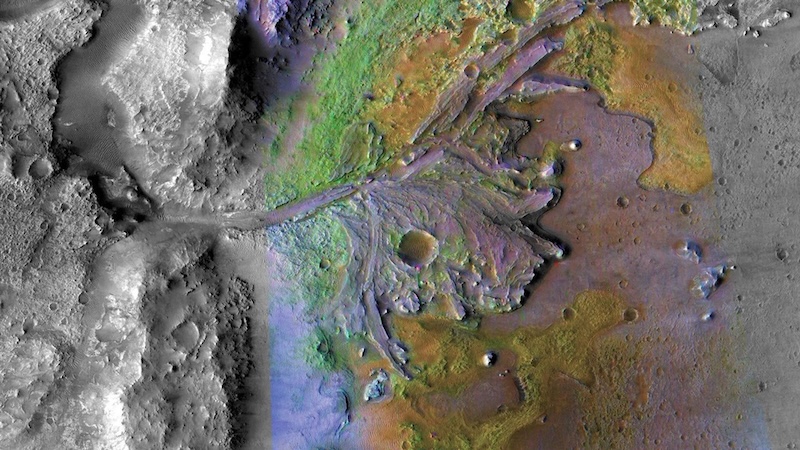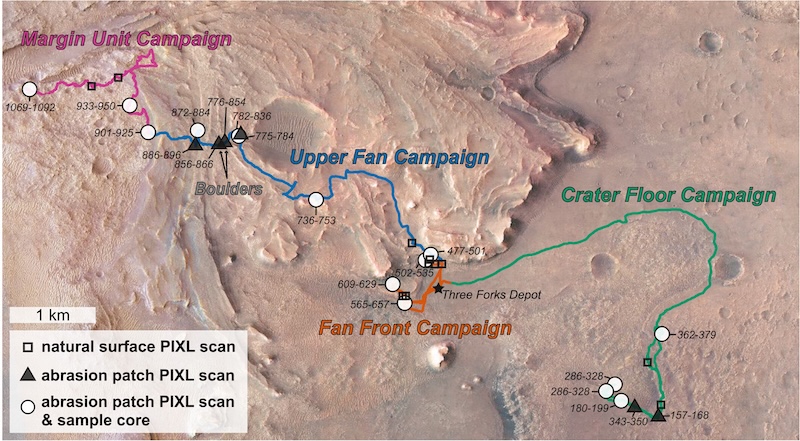 View larger. | Enhanced color image from Mars Reconnaissance Orbiter showing part of Jezero crater. In the middle of this image is an ancient delta formed by a river billions of years ago. New research shows that Jezero crater, the location of NASA’s Perseverance rover, experienced multiple periods of water and habitability. Image via NASA/ JPL-Caltech/ MSSS/ JHUAPL.
View larger. | Enhanced color image from Mars Reconnaissance Orbiter showing part of Jezero crater. In the middle of this image is an ancient delta formed by a river billions of years ago. New research shows that Jezero crater, the location of NASA’s Perseverance rover, experienced multiple periods of water and habitability. Image via NASA/ JPL-Caltech/ MSSS/ JHUAPL.
Jezero crater was once a lake billions of years ago. And it’s where the Perseverance rover landed in 2021. Was this area habitable?
The crater experienced multiple periods of habitability over time, new research shows.
Water in the crater shifted from acidic and hot early on, to cool and easily habitable later on.
Jezero crater was habitable multiple times
Earlier this month, NASA provided an update on the possible discovery of a biosignature by the Perseverance rover in Jezero crater. Now, another team of scientists has said the crater – which used to be a lake billions of years ago – experienced multiple periods of habitability. Water was more abundant during those periods of time. Eleanor Moreland at Rice University in Houston, Texas, led the new study. The researchers said on September 17, 2025, that Perseverance found two dozen types of minerals showing water altered volcanic rocks in the region. The evidence reveals three distinct periods of habitability. They shifted from least (but still potentially) habitable to the most habitable over time.
The findings support previous data from Perseverance revealing how this former landscape was once habitable by earthly standards.
The researchers published their peer-reviewed results in the journal JGR Planets on September 11, 2025.
New Mars research reveals multiple episodes of habitability in Jezero Crater?? news.rice.edu/news/2025/ne…?? doi.org/10.1029/2024…#Mars ? #PlanetSci
— Daniel Pomarède (@pomarede.bsky.social) 2025-09-22T15:36:39.387Z
Minerals provide clues
So, how did Perseverance determine multiple periods of habitability in Jezero crater? The rover found two dozen types of minerals that provided the clues. The minerals are in volcanic rocks that water had altered in the distant past.
Perseverance used its Planetary Instrument for X-ray Lithochemistry (PIXL) instrument for the analysis. PIXL bombards Martian rocks with X-rays to reveal their chemical composition. These are the most detailed geochemical measurements ever collected on another planet, the study authors said. Moreland explained:
The minerals we find in Jezero using MIST (Mineral Identification by Stoichiometry) support multiple, temporally distinct episodes of fluid alteration, which indicates there were several times in Mars’ history when these particular volcanic rocks interacted with liquid water and therefore more than one time when this location hosted environments potentially suitable for life.
 Eleanor Moreland at Rice University in Houston, Texas, is the lead author of the new study about past habitability in Jezero crater. Image via Rice University.
Eleanor Moreland at Rice University in Houston, Texas, is the lead author of the new study about past habitability in Jezero crater. Image via Rice University.
3 types of water alteration in Jezero crater
The analysis of the minerals revealed three different types of alteration by water.
The first involved localized high-temperature acidic fluids, with the minerals greenalite, hisingerite and ferroaluminoceladonite. These rocks, from the crater floor, were the oldest they studied. This water was very hot and acidic, making it the least habitable for microbes to exist in, although not impossible. Co-author Kirsten Siebach at Rice University said:
These hot, acidic conditions would be the most challenging for life. But on Earth, life can persist even in extreme environments like the acidic pools of water at Yellowstone, so it doesn’t rule out habitability.
Secondly, other minerals such as minnesotaite and clinoptilolite come from a period of water activity that was less acidic, with neutral pH, and cooler. Interestingly, the rover found minnesotaite in both the crater floor and the upper delta fan region, but clinoptilolite was only on the crater floor.
The third period of water alteration was the most habitable. The water was low temperature and alkaline (having a pH of more than 7). Perseverance found the mineral sepiolite all over the region it has explored so far. Its widespread presence shows that habitable conditions were also widespread at the time. Overall, the different minerals show how conditions changed from barely habitable to increasingly habitable over time. As Moreland said:
These minerals tell us that Jezero experienced a shift from harsher, hot, acidic fluids to more neutral and alkaline ones over time; conditions we think of as increasingly supportive of life.
 View larger. | Map from Mars Reconnaissance Orbiter showing the traverse of the Perseverance rover since landing and locations of various sampling spots. Image via NASA/ Moreland et al./ JGR Planets (CC BY 4.0).
View larger. | Map from Mars Reconnaissance Orbiter showing the traverse of the Perseverance rover since landing and locations of various sampling spots. Image via NASA/ Moreland et al./ JGR Planets (CC BY 4.0).
Using error analysis to study minerals
Perseverance’s onboard lab is powerful, but it still has limitations compared to labs on Earth. To help make the analysis as thorough as possible, the researchers used a statistical approach, repeatedly testing mineral identifications while considering the potential errors. This is similar to how meteorologists forecast hurricane tracks, by running many models and comparing them. Moreland said:
Our error analysis lets us assign confidence levels to every mineral match. MIST not only informs Mars 2020 science and decision-making, but it is also creating a mineralogical archive of Jezero crater that will be invaluable if samples are returned to Earth.
The approach paid off, revealing the complex water history of Jezero crater. And, combined with other results including the discovery of possible biosignatures in the crater, the results add further support to the idea that just maybe, Mars really was once home to microbial life.
Bottom line: New research shows that Mars’ Jezero crater, which was once home to a lake, was repeatedly habitable in the past.
Read more: NASA announces Mars rock as a potential biosignature
Read more: Rosalind Franklin rover: Finding Mars life might be easy
Paul Scott Anderson
View Articles
About the Author:
Paul Scott Anderson has had a passion for space exploration that began when he was a child when he watched Carl Sagan’s Cosmos. He studied English, writing, art and computer/publication design in high school and college. He later started his blog The Meridiani Journal in 2005, which was later renamed Planetaria. He also later started the blog Fermi Paradoxica, about the search for life elsewhere in the universe.
While interested in all aspects of space exploration, his primary passion is planetary science and SETI. In 2011, he started writing about space on a freelance basis with Universe Today. He has also written for SpaceFlight Insider and AmericaSpace and has also been published in The Mars Quarterly. He also did some supplementary writing for the iOS app Exoplanet.
He has been writing for EarthSky since 2018, and also assists with proofing and social media.
